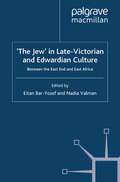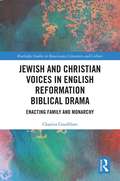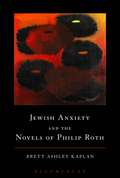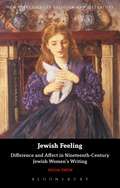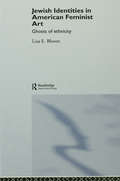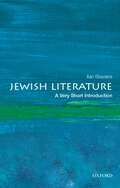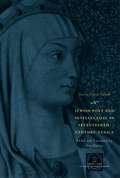- Table View
- List View
'The Jew' in Late-Victorian and Edwardian Culture: Between the East End and East Africa (Palgrave Studies in Nineteenth-Century Writing and Culture)
by E. Bar-Yosef N. ValmanThe turbulent period from the Boer War to the introduction of the Aliens Act was marked by contradictory imaginings of 'the Jew' - pauper/capitalist, separatist/imposter, ideal colonizer/undesirable immigrant, familiar/alien. This new collection considers the wider colonial context in which these ambivalent attitudes to Jews were produced.
The Jewel-Hinged Jaw: Notes on the Language of Science Fiction
by Samuel R. DelanySamuel R. Delany's The Jewel-Hinged Jaw appeared originally in 1977, and is now long out of print and hard to find. The impact of its demonstration that science fiction was a special language, rather than just gadgets and green-skinned aliens, began reverberations still felt in science fiction criticism. This edition includes two new essays, one written at the time and one written about those times, as well as an introduction by writer and teacher Matthew Cheney, placing Delany's work in historical context. Close textual analyses of Thomas M. Disch, Ursula K. Le Guin, Roger Zelazny, and Joanna Russ read as brilliantly today as when they first appeared. Essays such as "About 5,750 Words" and "To Read The Dispossessed" first made the book a classic; they assure it will remain one.
Jewish American Writing and World Literature: Maybe to Millions, Maybe to Nobody (Oxford Studies in American Literary History)
by Saul Noam ZarittJewish American Writing and World Literature: Maybe to Millions, Maybe to Nobody studies Jewish American writers' relationships with the idea of world literature. Writers such as Sholem Asch, Jacob Glatstein, Isaac Bashevis Singer, Anna Margolin, Saul Bellow, and Grace Paley all responded to a demand to write beyond local Jewish and American audiences and toward the world, as a global market and as a transnational ideal. Beyond fame and global circulation, world literature holds up the promise of legibility, in which a threatened origin becomes the site for redemptive literary creativity. But this promise inevitably remains unfulfilled, as writers struggle to balance potential universal achievements with untranslatable realities, rendering impossible any complete arrival in the US and in the world. The work examined in this study was deeply informed by an intimate connection to Yiddish, a Jewish vernacular with its own global network and institutional ambitions. Jewish American Writing and World Literature tracks the attempts and failures, through translation, to find a home for Jewish vernacularity in the institution of world literature. The exploration of the translational uncertainty of Jewish American writing joins postcolonial critiques of US and world literature and challenges Eurocentric and Anglo-American paradigms of literary study. In bringing into conversation the fields of Yiddish studies, American Studies, and world literature theory, Jewish American Writing and World Literature: Maybe to Millions, Maybe to Nobody proposes a new approach to the study of modern Jewish literatures and their implication within global empires of culture.
Jewish American Writing and World Literature: Maybe to Millions, Maybe to Nobody (Oxford Studies in American Literary History)
by Saul Noam ZarittJewish American Writing and World Literature: Maybe to Millions, Maybe to Nobody studies Jewish American writers' relationships with the idea of world literature. Writers such as Sholem Asch, Jacob Glatstein, Isaac Bashevis Singer, Anna Margolin, Saul Bellow, and Grace Paley all responded to a demand to write beyond local Jewish and American audiences and toward the world, as a global market and as a transnational ideal. Beyond fame and global circulation, world literature holds up the promise of legibility, in which a threatened origin becomes the site for redemptive literary creativity. But this promise inevitably remains unfulfilled, as writers struggle to balance potential universal achievements with untranslatable realities, rendering impossible any complete arrival in the US and in the world. The work examined in this study was deeply informed by an intimate connection to Yiddish, a Jewish vernacular with its own global network and institutional ambitions. Jewish American Writing and World Literature tracks the attempts and failures, through translation, to find a home for Jewish vernacularity in the institution of world literature. The exploration of the translational uncertainty of Jewish American writing joins postcolonial critiques of US and world literature and challenges Eurocentric and Anglo-American paradigms of literary study. In bringing into conversation the fields of Yiddish studies, American Studies, and world literature theory, Jewish American Writing and World Literature: Maybe to Millions, Maybe to Nobody proposes a new approach to the study of modern Jewish literatures and their implication within global empires of culture.
Jewish and Christian Voices in English Reformation Biblical Drama: Enacting Family and Monarchy (Routledge Studies in Renaissance Literature and Culture)
by Chanita GoodblattEnglish Biblical drama of the sixteenth century resounds with a variety of Jewish and Christian voices. Whether embodied as characters or manifested as exegetical and performative strategies, these voices participate in the central Reformation project of biblical translation. Such translations and dramatic texts are certainly enriched by studying them within the wider context of medieval and early modern biblical scholarship, which is implemented in biblical translations, commentaries and sermons. This approach is one significant contribution of the present project, as it studies the reciprocal illumination of Bible and Drama. Chanita Goodblatt explores the way in which the interpretive cruxes in the biblical text generate the dramatic text and performance, as well as how the drama’s enactment underlines the ethical and theological issues as the heart of the biblical text. By looking at English Reformation biblical drama through a double-edged prism of exegetical and performative perspectives, Goodblatt adds a new dimension to the existing discussion of the historical resonance of these plays. Jewish and Christian Voices in English Reformation Biblical Drama integrates Jewish and Christian exegetical traditions with the study of Reformation biblical drama. In doing so, this book recovers the interpretive and performative powers of both biblical and dramatic texts.
Jewish and Christian Voices in English Reformation Biblical Drama: Enacting Family and Monarchy (Routledge Studies in Renaissance Literature and Culture)
by Chanita GoodblattEnglish Biblical drama of the sixteenth century resounds with a variety of Jewish and Christian voices. Whether embodied as characters or manifested as exegetical and performative strategies, these voices participate in the central Reformation project of biblical translation. Such translations and dramatic texts are certainly enriched by studying them within the wider context of medieval and early modern biblical scholarship, which is implemented in biblical translations, commentaries and sermons. This approach is one significant contribution of the present project, as it studies the reciprocal illumination of Bible and Drama. Chanita Goodblatt explores the way in which the interpretive cruxes in the biblical text generate the dramatic text and performance, as well as how the drama’s enactment underlines the ethical and theological issues as the heart of the biblical text. By looking at English Reformation biblical drama through a double-edged prism of exegetical and performative perspectives, Goodblatt adds a new dimension to the existing discussion of the historical resonance of these plays. Jewish and Christian Voices in English Reformation Biblical Drama integrates Jewish and Christian exegetical traditions with the study of Reformation biblical drama. In doing so, this book recovers the interpretive and performative powers of both biblical and dramatic texts.
Jewish Anxiety and the Novels of Philip Roth
by Brett Ashley KaplanJewish Anxiety and the Novels of Philip Roth argues that Roth's novels teach us that Jewish anxiety stems not only from fear of victimization but also from fear of perpetration. It is impossible to think about Jewish victimization without thinking about the Holocaust; and it is impossible to think about the taboo question of Jewish perpetration without thinking about Israel. Roth's texts explore the Israel-Palestine question and the Holocaust with varying degrees of intensity but all his novels scrutinize perpetration and victimization through examining racism and sexism in America. Brett Ashley Kaplan uses Roth's novels as springboards to illuminate larger problems of victimization and perpetration; masculinity, femininity, and gender; racism and anti-Semitism. For if, as Kaplan argues, Jewish anxiety is not only about the fear of oppression, and we can begin to see how these anxieties function in terms of fears of perpetration, then perhaps we can begin to unpack the complicated dynamics around the line between the Holocaust and Israel-Palestine.
Jewish Anxiety and the Novels of Philip Roth
by Brett Ashley KaplanJewish Anxiety and the Novels of Philip Roth argues that Roth's novels teach us that Jewish anxiety stems not only from fear of victimization but also from fear of perpetration. It is impossible to think about Jewish victimization without thinking about the Holocaust; and it is impossible to think about the taboo question of Jewish perpetration without thinking about Israel. Roth's texts explore the Israel-Palestine question and the Holocaust with varying degrees of intensity but all his novels scrutinize perpetration and victimization through examining racism and sexism in America. Brett Ashley Kaplan uses Roth's novels as springboards to illuminate larger problems of victimization and perpetration; masculinity, femininity, and gender; racism and anti-Semitism. For if, as Kaplan argues, Jewish anxiety is not only about the fear of oppression, and we can begin to see how these anxieties function in terms of fears of perpetration, then perhaps we can begin to unpack the complicated dynamics around the line between the Holocaust and Israel-Palestine.
Jewish Comics and Graphic Narratives: A Critical Guide (Bloomsbury Comics Studies)
by Matt ReingoldThe most up-to-date critical guide mapping the history, impact, key critical issues, and seminal texts of the genre, Jewish Comics and Graphic Narratives interrogates what makes a work a "Jewish graphic narrative", and explores the form's diverse facets to orient readers to the richness and complexity of Jewish graphic storytelling. Accessible but comprehensive and in an easy-to-navigate format, the book covers such topics as:- The history of the genre in the US and Israel - and its relationship to superheroes, Underground Comix, and Jewish literature- Social and cultural discussions surrounding the legitimization of graphic representation as sites of trauma, understandings of gender, mixed-media in Jewish graphic novels, and the study of these works in the classroom- Critical explorations of graphic narratives about the Holocaust, Israel, the diasporic experience, Judaism, and autobiography and memoir- The works of Will Eisner, Ilana Zeffren, James Sturm, Joann Sfar, JT Waldman, Michel Kichka, Sarah Glidden, Rutu Modan, and Art Spiegelman and such narratives as X Men, Anne Frank's Diary, and Maus Jewish Comics and Graphic Novels includes an appendix of relevant works sorted by genre, a glossary of crucial critical terms, and close readings of key texts to help students and readers develop their understanding of the genre and pursue independent study.
Jewish Comics and Graphic Narratives: A Critical Guide (Bloomsbury Comics Studies)
by Matt ReingoldThe most up-to-date critical guide mapping the history, impact, key critical issues, and seminal texts of the genre, Jewish Comics and Graphic Narratives interrogates what makes a work a "Jewish graphic narrative", and explores the form's diverse facets to orient readers to the richness and complexity of Jewish graphic storytelling. Accessible but comprehensive and in an easy-to-navigate format, the book covers such topics as:- The history of the genre in the US and Israel - and its relationship to superheroes, Underground Comix, and Jewish literature- Social and cultural discussions surrounding the legitimization of graphic representation as sites of trauma, understandings of gender, mixed-media in Jewish graphic novels, and the study of these works in the classroom- Critical explorations of graphic narratives about the Holocaust, Israel, the diasporic experience, Judaism, and autobiography and memoir- The works of Will Eisner, Ilana Zeffren, James Sturm, Joann Sfar, JT Waldman, Michel Kichka, Sarah Glidden, Rutu Modan, and Art Spiegelman and such narratives as X Men, Anne Frank's Diary, and Maus Jewish Comics and Graphic Novels includes an appendix of relevant works sorted by genre, a glossary of crucial critical terms, and close readings of key texts to help students and readers develop their understanding of the genre and pursue independent study.
The Jewish Decadence: Jews and the Aesthetics of Modernity
by Jonathan FreedmanAs Jewish writers, artists, and intellectuals made their way into Western European and Anglo-American cultural centers, they encountered a society obsessed with decadence. An avant-garde movement characterized by self-consciously artificial art and literature, philosophic pessimism, and an interest in nonnormative sexualities, decadence was also a smear, whereby Jews were viewed as the source of social and cultural decline. In The Jewish Decadence, Jonathan Freedman argues that Jewish engagement with decadence played a major role in the emergence of modernism and the making of Jewish culture from the 1870s to the present. The first to tell this sweeping story, Freedman demonstrates the centrality of decadence to the aesthetics of modernity and its inextricability from Jewishness. Freedman recounts a series of diverse and surprising episodes that he insists do not belong solely to the past, but instead reveal that the identification of Jewishness with decadence persists today.
The Jewish Decadence: Jews and the Aesthetics of Modernity
by Jonathan FreedmanAs Jewish writers, artists, and intellectuals made their way into Western European and Anglo-American cultural centers, they encountered a society obsessed with decadence. An avant-garde movement characterized by self-consciously artificial art and literature, philosophic pessimism, and an interest in nonnormative sexualities, decadence was also a smear, whereby Jews were viewed as the source of social and cultural decline. In The Jewish Decadence, Jonathan Freedman argues that Jewish engagement with decadence played a major role in the emergence of modernism and the making of Jewish culture from the 1870s to the present. The first to tell this sweeping story, Freedman demonstrates the centrality of decadence to the aesthetics of modernity and its inextricability from Jewishness. Freedman recounts a series of diverse and surprising episodes that he insists do not belong solely to the past, but instead reveal that the identification of Jewishness with decadence persists today.
The Jewish Diaspora in Latin America: New Studies on History and Literature
by David Sheinin Lois Baer BarrFirst published in 1996. Routledge is an imprint of Taylor & Francis, an informa company.
The Jewish Diaspora in Latin America: New Studies on History and Literature
by David Sheinin Lois Baer BarrFirst published in 1996. Routledge is an imprint of Taylor & Francis, an informa company.
Jewish Feeling: Difference and Affect in Nineteenth-Century Jewish Women's Writing (New Directions in Religion and Literature)
by Richa DworJewish Feeling brings together affect theory and Jewish Studies to trace Jewish difference in literary works by nineteenth-century Anglo-Jewish authors. Dwor argues that midrash, a classical rabbinic interpretive form, is a site of Jewish feeling and that literary works underpinned by midrashic concepts engage affect in a distinctly Jewish way. The book thus emphasises the theological function of literature and also the new opportunities afforded by nineteenth-century literary forms for Jewish women's theological expression. For authors such as Grace Aguilar (1816-1847) and Amy Levy (1861-1889), feeling is a complex and overlapping category that facilitates the transmission of Jewish ways of thinking into English literary forms. Dwor reads them alongside George Eliot, herself deeply engaged with issues of contemporary Jewish identity. This sheds new light on Eliot by positioning her works in a nexus of Jewish forms and concerns. Ultimately, and despite considerable differences in style and outlook, Aguilar and Levy are shown to deploy Jewish feeling in their ethics of futurity, resistance to conversion and closure, and in their foregrounding of a model of reading with feeling.
Jewish Feeling: Difference and Affect in Nineteenth-Century Jewish Women's Writing (New Directions in Religion and Literature)
by Richa DworJewish Feeling brings together affect theory and Jewish Studies to trace Jewish difference in literary works by nineteenth-century Anglo-Jewish authors. Dwor argues that midrash, a classical rabbinic interpretive form, is a site of Jewish feeling and that literary works underpinned by midrashic concepts engage affect in a distinctly Jewish way. The book thus emphasises the theological function of literature and also the new opportunities afforded by nineteenth-century literary forms for Jewish women's theological expression. For authors such as Grace Aguilar (1816-1847) and Amy Levy (1861-1889), feeling is a complex and overlapping category that facilitates the transmission of Jewish ways of thinking into English literary forms. Dwor reads them alongside George Eliot, herself deeply engaged with issues of contemporary Jewish identity. This sheds new light on Eliot by positioning her works in a nexus of Jewish forms and concerns. Ultimately, and despite considerable differences in style and outlook, Aguilar and Levy are shown to deploy Jewish feeling in their ethics of futurity, resistance to conversion and closure, and in their foregrounding of a model of reading with feeling.
Jewish Identities in American Feminist Art: Ghosts of Ethnicity
by Lisa E. BloomFeaturing sixty-seven illustrations, and providing an important reckoning and visualization of the previously hidden Jewish 'ghosts' within US art, Jewish Identities in American Feminist Art addresses the veiled role of Jewishness in the understanding of feminist art in the United States. From New York city to Southern California, Lisa E. Bloom situates the art practices of Jewish feminist artists from the 1970s to the present in relation to wider cultural and historical issues. Key themes are examined in depth through the work of contemporary Jewish artists including: Eleanor Antin Judy Chicago Deborah Kass Rhonda Lieberman Martha Rosler and many others. Crucial in any study of art, visual studies, women's studies and cultural studies, this is a new and lively exploration into a vital component of US art.
Jewish Identities in American Feminist Art: Ghosts of Ethnicity
by Lisa E. BloomFeaturing sixty-seven illustrations, and providing an important reckoning and visualization of the previously hidden Jewish 'ghosts' within US art, Jewish Identities in American Feminist Art addresses the veiled role of Jewishness in the understanding of feminist art in the United States. From New York city to Southern California, Lisa E. Bloom situates the art practices of Jewish feminist artists from the 1970s to the present in relation to wider cultural and historical issues. Key themes are examined in depth through the work of contemporary Jewish artists including: Eleanor Antin Judy Chicago Deborah Kass Rhonda Lieberman Martha Rosler and many others. Crucial in any study of art, visual studies, women's studies and cultural studies, this is a new and lively exploration into a vital component of US art.
Jewish Identity in Western Pop Culture: The Holocaust and Trauma Through Modernity
by J. StrattonThis book looks at the post-Holocaust experience with emphasis on aspects of its impact on popular culture.
Jewish Imaginaries of the Spanish Civil War: In Search of Poetic Justice (Comparative Jewish Literatures)
by Cynthia GabbayJewish Imaginaries of the Spanish Civil War inaugurates a new field of research in literary and Jewish studies at the intersection of Jewish history and the internationalist cultural phenomenon emerging from the Spanish Civil War (1936–1939), the Republican exile, and the Shoah. With the Spanish Civil War as a point of departure, this volume proposes a definition of Jewish textualities based on the entanglement of multiple poetic modes. Through the examination of a variety of narrative fiction and non-fiction, memoir, poetry, epistles, journalism, and music in Yiddish, Spanish, French, German, and English, these essays unveil non-canonic authors across the West and explore these works in the context of antisemitism, orientalism, and philo-Sephardism, among other cultural phenomena. Jewish writings from the war have much to tell about the encounter between old traditions and new experimentations, framed by urgency, migration, and messianic hope. They offer perspectives on memorial and post-memorial literatures triggered by transhistorical imagination, and many were written against the grain of canonic literature, where subtle forms of dissidence, manifested through language, structure, sound, and thought, sought to tune with the anti-fascist fight. This book revindicates the polyglossia of Jewish cultures and literatures in the context of genocide and epistemicide and proposes to remember the cultural phenomena produced by the Spanish Civil War, demanding a new understanding of the cosmopolitan imaginaries in Jewish literature.
Jewish Imaginaries of the Spanish Civil War: In Search of Poetic Justice (Comparative Jewish Literatures)
Jewish Imaginaries of the Spanish Civil War inaugurates a new field of research in literary and Jewish studies at the intersection of Jewish history and the internationalist cultural phenomenon emerging from the Spanish Civil War (1936–1939), the Republican exile, and the Shoah. With the Spanish Civil War as a point of departure, this volume proposes a definition of Jewish textualities based on the entanglement of multiple poetic modes. Through the examination of a variety of narrative fiction and non-fiction, memoir, poetry, epistles, journalism, and music in Yiddish, Spanish, French, German, and English, these essays unveil non-canonic authors across the West and explore these works in the context of antisemitism, orientalism, and philo-Sephardism, among other cultural phenomena. Jewish writings from the war have much to tell about the encounter between old traditions and new experimentations, framed by urgency, migration, and messianic hope. They offer perspectives on memorial and post-memorial literatures triggered by transhistorical imagination, and many were written against the grain of canonic literature, where subtle forms of dissidence, manifested through language, structure, sound, and thought, sought to tune with the anti-fascist fight. This book revindicates the polyglossia of Jewish cultures and literatures in the context of genocide and epistemicide and proposes to remember the cultural phenomena produced by the Spanish Civil War, demanding a new understanding of the cosmopolitan imaginaries in Jewish literature.
Jewish Literature: 1,000 Years Of Jewish-hispanic Literature (Very Short Introductions)
by Ilan StavansThe story of Jewish literature is a kaleidoscopic one, multilingual and transnational in character, spanning the globe as well as the centuries. In this broad, thought-provoking introduction to Jewish literature from 1492 to the present, cultural historian Ilan Stavans focuses on its multilingual and transnational nature. Stavans presents a wide range of traditions within Jewish literature and the variety of writers who made those traditions possible. Represented are writers as dissimilar as Luis de Carvajal the Younger, Franz Kafka, Bruno Schulz, Isaac Babel, Anzia Yezierska, Elias Canetti, Isaac Bashevis Singer, Irving Howe, Clarice Lispector, Susan Sontag, Philip Roth, Grace Paley, Amos Oz, Moacyr Scliar, and David Grossman. The story of Jewish literature spans the globe as well as the centuries, from the marrano poets and memorialists of medieval Spain, to the sprawling Yiddish writing in Ashkenaz (the "Pale of Settlement' in Eastern Europe), to the probing narratives of Jewish immigrants to the United States and other parts of the New World. It also examines the accounts of horror during the Holocaust, the work of Israeli authors since the creation of the Jewish State in 1948, and the "ingathering" of Jewish works in Brazil, Bulgaria, Argentina, and South Africa at the end of the twentieth century. This kaleidoscopic introduction to Jewish literature presents its subject matter as constantly changing and adapting.
Jewish Literature: A Very Short Introduction (Very Short Introductions)
by Ilan StavansThe story of Jewish literature is a kaleidoscopic one, multilingual and transnational in character, spanning the globe as well as the centuries. In this broad, thought-provoking introduction to Jewish literature from 1492 to the present, cultural historian Ilan Stavans focuses on its multilingual and transnational nature. Stavans presents a wide range of traditions within Jewish literature and the variety of writers who made those traditions possible. Represented are writers as dissimilar as Luis de Carvajal the Younger, Franz Kafka, Bruno Schulz, Isaac Babel, Anzia Yezierska, Elias Canetti, Isaac Bashevis Singer, Irving Howe, Clarice Lispector, Susan Sontag, Philip Roth, Grace Paley, Amos Oz, Moacyr Scliar, and David Grossman. The story of Jewish literature spans the globe as well as the centuries, from the marrano poets and memorialists of medieval Spain, to the sprawling Yiddish writing in Ashkenaz (the "Pale of Settlement' in Eastern Europe), to the probing narratives of Jewish immigrants to the United States and other parts of the New World. It also examines the accounts of horror during the Holocaust, the work of Israeli authors since the creation of the Jewish State in 1948, and the "ingathering" of Jewish works in Brazil, Bulgaria, Argentina, and South Africa at the end of the twentieth century. This kaleidoscopic introduction to Jewish literature presents its subject matter as constantly changing and adapting.
The Jewish Persona in the European Imagination: A Case of Russian Literature (Stanford Studies in Jewish History and Culture)
by Leonid LivakThis book proposes that the idea of the Jews in European cultures has little to do with actual Jews, but rather is derived from the conception of Jews as Christianity's paradigmatic Other, eternally reenacting their morally ambiguous New Testament role as the Christ-bearing and -killing chosen people of God. Through new readings of canonical Russian literary texts by Gogol, Turgenev, Chekhov, Babel, and others, the author argues that these European writers—Christian, secular, and Jewish—based their representation of Jews on the Christian exegetical tradition of anti-Judaism. Indeed, Livak disputes the classification of some Jewish writers as belonging to "Jewish literature," arguing that such an approach obscures these writers' debt to European literary traditions and their ambivalence about their Jewishness. This work seeks to move the study of Russian literature, and Russian-Jewish literature in particular, down a new path. It will stir up controversy around Christian-Jewish cultural interaction; the representation of otherness in European arts and folklore; modern Jewish experience; and Russian literature and culture.
Jewish Poet and Intellectual in Seventeenth-Century Venice: The Works of Sarra Copia Sulam in Verse and Prose Along with Writings of Her Contemporaries in Her Praise, Condemnation, or Defense (The Other Voice in Early Modern Europe)
by Sarra Copia SulamThe first Jewish woman to leave her mark as a writer and intellectual, Sarra Copia Sulam (1600?–41) was doubly tainted in the eyes of early modern society by her religion and her gender. This remarkable woman, who until now has been relatively neglected by modern scholarship, was a unique figure in Italian cultural life, opening her home, in the Venetian ghetto, to Jews and Christians alike as a literary salon. For this bilingual edition, Don Harrán has collected all of Sulam’s previously scattered writings—letters, sonnets, a Manifesto—into a single volume. Harrán has also assembled all extant correspondence and poetry that was addressed to Sulam, as well as all known contemporary references to her, making them available to Anglophone readers for the first time. Featuring rich biographical and historical notes that place Sulam in her cultural context, this volume will provide readers with insight into the thought and creativity of a woman who dared to express herself in the male-dominated, overwhelmingly Catholic Venice of her time.
